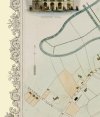Oh dear, I think we are getting confused between the canal reservoir and the public drinking water supply.
The canal reservoir
Like Dave Riley, I did not realise that the canal company had a pumping station for the canal reservoir – presumably installed by Thomas Telford as part of his major improvements to the system in the 1820s. I always thought that the main supply to Rotton Park reservoir came by gravity along the feeder cut from the Titford Reservoir near Oldbury (511 feet above sea level) down to Edgbaston Reservoir (altitude about 480 feet). From there, a sluice discharged water into the Icknield Port loop of the canal system, (altitude 453 feet). The original canal followed this loop on its way to Wolverhampton and Wednesbury, but had to rise another 38 feet over the Smethwick Summit. The source of water there was the Thimblemill Brook, but supply was always short at the summit, even with a primitive steam engine used to pump water back up, because of the frequent opening of the lock gates, which drained the canal as rapidly as it could be replenished. A new engine house was built in 1779 with a steam engine built by Boulton and Watt, which remained in use until 1892. In the 1780s the cutting was deepened to replace the top six locks, bringing the altitude at the summit down to 473 feet.
According to his biographer, Samuel Smiles, Telford in 1817 found the canal “little better than a crooked ditch, with scarcely the appearance of a towing path, the horses frequently sliding and staggering into the water, the hauling-lines sweeping the gravel into the canal, and the entanglement at the meeting of boats being incessant; whilst at the locks at each end of the short summit at Smethwick, crowds of boatmen were always quarrelling, or offering premiums for a preference of passage.” His works were largely completed by 1830, but further projects were carried out later in the 19th century.
Now back to water supply
The Birmingham Waterworks Company was set up in 1826 and opened a reservoir taking water from the River Tame and the Hawthorn Brook near Salford Bridge. Water was pumped up to a site just south-east of Rotton Park canal reservoir to a separate, smaller, reservoir, but a few feet higher than the latter. It ids clearly shown on Bordesley Exile’s map. Like all early drinking water reservoirs, it was originally open to the elements, and tended to accumulate algae and decaying leaves, so it was soon covered over. As the town grew, so did demand for water, including in areas that were higher than the Edgbaston reservoir, so another reservoir was built 70 feet higher, just south of the Hagley Road near the junction with Sandon Road, opened in 1853. This provided enough pressure to serve such areas as Moseley and Bearwood. The elegant chimney of the new pumping house at Edgbaston is a local landmark, designed by J. H. Chamberlain, also illustrated by Bordesley Exile.
I hope that clarifies some of the confusion
Peter

